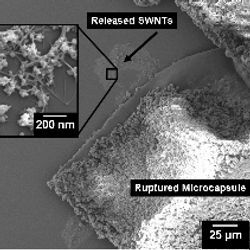
Researchers are working on "self-healing" electronic materials that could lead in time to computer components that can fix themselves when they break.
At the University of Illinois Department of Chemistry, researchers are working on ways to repair materials damaged under conditions such as high temperature. They are investigating the release of liquid content from microcapsules to restore functionality such as electrical conductivity in damaged electronics.
To that end, the department is developing a technique in which materials such as carbon nanotubes are suspended in organic solvents that are encapsulated within polymer-based microcapsules. The shells erode under conditions such as temperature spikes and mechanical damage to release the suspensions and deliver conductive components where they’re needed, restoring current in damaged conductors.
The researchers have seen promising results and will continue to work on the process over the coming year. They plan to investigate variations on the encapsulation process, and to test the ability to encapsulate other components including nanoparticles and carbon-rich molecular fragments. They also plan to develop capsules that trigger the release of their contents based on various stimuli.
"We’re far from seeing this in commercial applications. What we have done is a proof of principle only," notes Jeffrey Moore, a professor of chemistry, materials science and engineering at the University of Illinois, Urbana, Ill.
New materials — "healing agents for electronics" — are needed that can be transported to the site of damage, Moore says. By exploring a variety of triggers, microencapsulated agents can be released to restore electronic properties to their original value. Could this technique fix failed circuits due to faulty transistors? "Not today or anytime in the near term, but conceptually, this is a very reasonable idea," he says.
Convenient Conversion
The University of Texas in Austin is also developing self-healing materials. "Our efforts have focused on creating structurally-dynamic, electrically-conductive materials," says Christopher Bielawski, associate professor of chemistry.
The materials are durable, conductive solids at room temperature, but if cracked they can be conveniently converted into a liquid, which allows them to flow into damaged areas. "At that point, the materials can be reverted back into their solid forms, which effectively ‘heals’ the damaged areas," Bielawski says.
The process can be applied to fixing failed circuits. "In fact, we are currently working on self-healing transistors, and other semiconductor materials as well," Bielawski says. "We are also trying to capitalize on the reconfigurable nature of our materials to improve the performance of transistors and other solid state devices."
While the process is too expensive to interest manufacturers at this point, Bielawski says, researchers are working on practical, inexpensive alternatives that might eventually be broadly applicable.
"It will not be long before computers with self-healing technologies are sold at places like Best Buy or Wal-Mart," Bielawski says. "They will make electronics significantly more durable, enabling more efficient communication and stronger connections."



Join the Discussion (0)
Become a Member or Sign In to Post a Comment